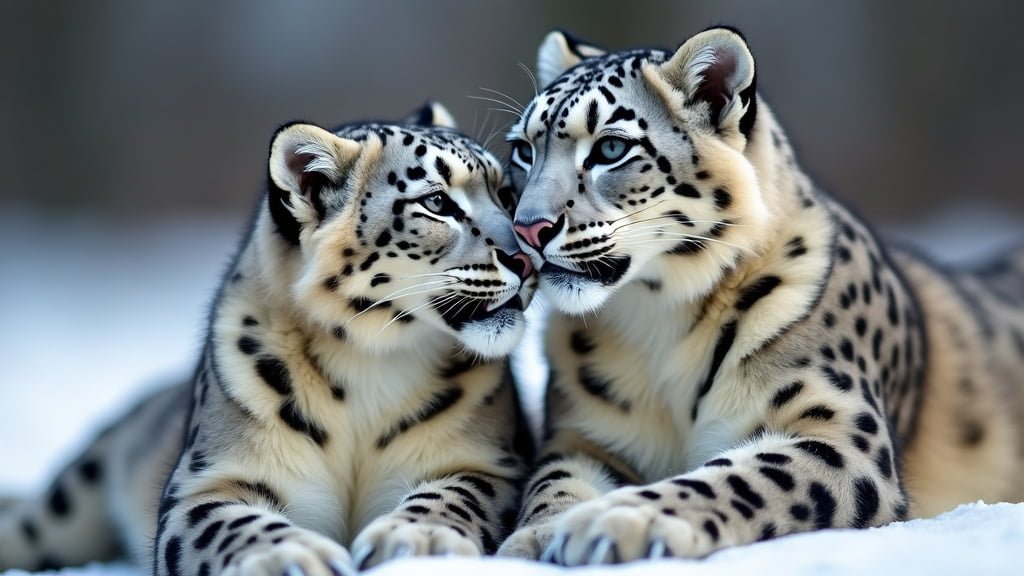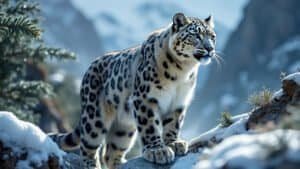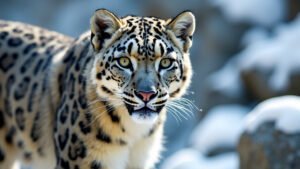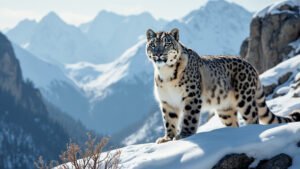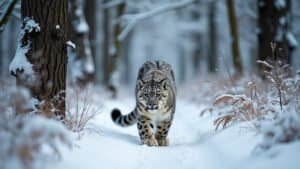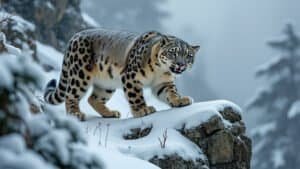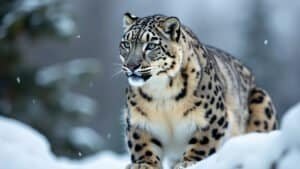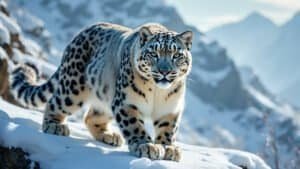Introduction
The reproductive success of snow leopards is deeply intertwined with their genetic makeup. This article explores the specific genes that influence their reproductive health, how genetic diversity and mutations play a role in fertility, and the impact of inbreeding on their viability
We will delve into key genetic markers, the consequences of low diversity, and the evolutionary advantages that certain traits confer. Understanding these genetic factors is crucial for the conservation of this endangered species, ensuring that they continue to thrive in their natural habitats
Key Genes Linked to Snow Leopards’ Reproductive Health
Snow leopards, like many other species, rely heavily on their genetic makeup for successful reproduction. The identification of specific genes linked to reproductive health is crucial, as these genes directly affect fertility, mating behaviors, and offspring survival
By studying these genetic markers, researchers can gain insights into the evolutionary adaptations of snow leopards and the genetic factors that may pose challenges to their reproduction
This section delves into the key genes identified in snow leopards that influence their reproductive success and how these genes contribute to the species’ overall fitness
Understanding Genetic Markers
Genetic markers are segments of DNA that are associated with specific traits, including those linked to reproduction. In snow leopards, several genetic markers have been identified that correlate with reproductive health
One of the most significant markers is the ZP3 gene, which plays a crucial role in the fertilization process. The ZP3 gene encodes for a glycoprotein in the zona pellucida, a structure that surrounds the egg and is essential for sperm binding and penetration during fertilization
Another important gene is AMH (Anti-Müllerian Hormone), which influences the development of reproductive organs in both male and female snow leopards. High levels of AMH are associated with better fertility outcomes, particularly in females, where it helps regulate the formation of ovarian follicles, critical for egg production
Impact of Gene Variability on Fertility
Gene variability, or the presence of different alleles within a population, can significantly impact fertility in snow leopards. Heterozygosity, the presence of different alleles at a gene locus, is often linked to higher fertility rates
Studies have shown that snow leopards with higher genetic variability at critical reproductive loci, such as the MHC (Major Histocompatibility Complex) genes, tend to have better reproductive success. The MHC genes are responsible for immune system function, and their variability ensures that offspring have a robust immune response, indirectly supporting reproductive success by increasing survival rates
Conversely, homozygosity, where identical alleles are present at a locus, can lead to reduced fertility. In snow leopards, reduced genetic diversity in key reproductive genes has been associated with lower sperm quality and decreased ovarian function, ultimately impacting the number of viable offspring produced
Role of Specific Genes in Reproduction
Certain genes in snow leopards are directly linked to reproductive behaviors and success. The PRL (Prolactin) gene, for instance, is critical in the regulation of parental care behaviors, especially in female snow leopards
Prolactin influences milk production and maternal behaviors, which are vital for the survival of cubs. Variations in the PRL gene can lead to differences in the quality of maternal care, impacting cub survival rates
Another gene of interest is the CYP19A1 gene, which is involved in the biosynthesis of estrogen, a hormone that regulates the estrous cycle and reproductive readiness in females. Variations in this gene can affect hormone levels, influencing mating behaviors and the timing of reproduction, which are crucial for synchronizing mating with optimal environmental conditions
Overall, these genetic markers and their variability play a pivotal role in shaping the reproductive success of snow leopards. Understanding these genetic influences not only helps in conservation efforts but also provides a deeper insight into the evolutionary strategies that have allowed snow leopards to survive in their harsh natural environments
Effects of Genetic Diversity on Snow Leopard Fertility
Genetic diversity is a cornerstone of any species’ survival, including snow leopards. It influences not only the overall health and adaptability of a population but also directly affects reproductive success
In snow leopards, genetic diversity is crucial for maintaining robust fertility rates and reducing the likelihood of inherited genetic disorders
This section examines the importance of genetic diversity in snow leopards, the consequences of low genetic diversity, and case studies that highlight how genetic variation impacts reproductive success
The Importance of Genetic Diversity
Genetic diversity refers to the variety of genes within a population. For snow leopards, this diversity is essential for maintaining healthy populations capable of adapting to changing environments
High genetic diversity ensures a wider range of traits within the population, which can contribute to better fertility and reproductive success. For instance, snow leopards with greater genetic variation in their MHC (Major Histocompatibility Complex) genes are better equipped to fend off diseases, which indirectly supports reproductive success by enhancing the health and survival rates of both parents and offspring
Additionally, genetic diversity helps to minimize the risk of inheriting deleterious mutations that can negatively affect fertility. A population with high genetic diversity is less likely to suffer from genetic bottlenecks, where reduced diversity can lead to inbreeding and the subsequent expression of harmful recessive traits
Consequences of Low Genetic Diversity
Low genetic diversity can have severe consequences for the fertility and reproductive viability of snow leopards
Inbreeding, which often occurs in small or isolated populations with limited genetic diversity, can lead to inbreeding depression, a phenomenon where inbred individuals exhibit reduced fitness, including lower fertility rates and higher susceptibility to diseases
In snow leopards, inbreeding depression has been associated with a decline in sperm quality, increased incidence of birth defects, and reduced survival rates of cubs
One study conducted by Sharma et al. (2016) on snow leopard populations in the Himalayas found that inbreeding led to a significant reduction in litter sizes and increased cub mortality. The lack of genetic diversity in these populations exacerbated the effects of environmental stressors, making it more difficult for the population to recover and grow
Case Studies on Genetic Diversity and Reproductive Success
Several case studies illustrate the critical role of genetic diversity in snow leopard reproduction. A notable example is the population of snow leopards in Mongolia’s Altai Mountains, where conservation efforts have focused on maintaining and increasing genetic diversity through careful monitoring and managed breeding programs
Research by McCarthy et al. (2017) revealed that populations with higher genetic diversity exhibited better reproductive outcomes, including larger litter sizes and higher cub survival rates
In contrast, populations in more isolated regions, such as certain areas of the Tibetan Plateau, have shown signs of reduced genetic diversity and corresponding declines in reproductive success
These findings underscore the importance of preserving genetic diversity as a key component of conservation strategies for snow leopards
Genetic Mutations and Their Impact on Reproductive Success
Genetic mutations are changes in the DNA sequence that can have varying effects on an organism’s traits, including reproduction. In snow leopards, some mutations can be beneficial, conferring advantages in harsh environments, while others may be detrimental, leading to reduced fertility or viability
Understanding the role of genetic mutations in snow leopard populations is crucial for grasping how these changes influence reproductive success and the long-term survival of the species
This section explores common genetic mutations in snow leopards, their effects on reproductive health, and the potential long-term consequences of these mutations
Common Genetic Mutations in Snow Leopards
Snow leopards, like all species, experience genetic mutations that can influence their physiology and reproductive capabilities. One notable mutation is found in the EPAS1 gene, which is associated with the ability to thrive at high altitudes where oxygen levels are low
This mutation is critical for snow leopards, who inhabit some of the highest mountain ranges in the world. While the EPAS1 mutation provides a survival advantage, it has also been linked to reproductive challenges
For instance, mutations in EPAS1 can lead to complications in pregnancy due to the altered oxygen-carrying capacity in the blood, potentially impacting cub survival rates
Another mutation of interest is in the KISS1 gene, which plays a role in regulating the reproductive hormone cascade. Mutations in this gene can disrupt normal reproductive cycles, leading to irregular estrous cycles in females or reduced sperm production in males
This can result in lower fertility rates, which may impact the overall population growth of snow leopards
How Mutations Affect Reproductive Health
Mutations can have a range of effects on reproductive health, depending on their nature and location in the genome. Some mutations are deleterious, meaning they negatively impact an organism’s fitness
In snow leopards, deleterious mutations in reproductive genes can lead to subfertility, a condition where the ability to reproduce is significantly diminished. For example, mutations in the ESR1 gene, which encodes for estrogen receptors, can impair hormone signaling and disrupt normal reproductive functions, leading to lower pregnancy rates and fewer offspring
Conversely, some mutations might be beneficial or neutral in terms of reproductive success. Beneficial mutations may enhance reproductive success by conferring traits that improve mating success or cub survival
However, the accumulation of harmful mutations, especially in small, inbred populations, can lead to a decline in overall reproductive health, as seen in several isolated snow leopard populations where genetic diversity is low
Long-Term Effects of Genetic Mutations
The long-term effects of genetic mutations on snow leopard populations depend largely on the balance between beneficial and harmful mutations
Over time, harmful mutations can become more prevalent if they are not purged from the population through natural selection, particularly in small populations where genetic drift plays a significant role
This can lead to a phenomenon known as mutational meltdown, where the accumulation of deleterious mutations drives a decline in population fitness and reproductive success
In snow leopards, maintaining a balance between genetic mutations that confer survival advantages and those that negatively impact reproduction is crucial for the species’ long-term viability. Conservation efforts that monitor and manage genetic diversity can help mitigate the potential negative impacts of harmful mutations
For example, a study by Janecka et al. (2015) highlighted the importance of genetic monitoring in snow leopard populations to identify and manage the spread of harmful mutations
By understanding the specific mutations present in a population, conservationists can make informed decisions about breeding programs and habitat management to support healthy, genetically diverse populations
Inbreeding and Its Influence on Snow Leopard Reproductive Viability
Inbreeding, the mating of closely related individuals, is a significant concern for species with small or isolated populations, such as snow leopards. It reduces genetic diversity and increases the likelihood of inheriting harmful genetic traits, which can severely affect reproductive viability
In snow leopards, inbreeding has been linked to various reproductive challenges, including lower fertility rates and increased instances of genetic disorders
This section explores the causes and consequences of inbreeding in snow leopards, its impact on fertility and reproductive health, and strategies for mitigating these effects to preserve the species
Causes and Consequences of Inbreeding
Inbreeding occurs primarily in small, isolated populations where the gene pool is limited. For snow leopards, habitat fragmentation due to human activities, such as deforestation and urbanization, has led to isolated populations that are more prone to inbreeding
When snow leopards are unable to migrate and interbreed with other populations, the genetic diversity within a population decreases, leading to higher inbreeding rates
The consequences of inbreeding are profound. One of the most significant effects is inbreeding depression, where inbred individuals display reduced biological fitness. In snow leopards, inbreeding depression has been observed in the form of decreased litter sizes, lower cub survival rates, and a higher prevalence of genetic disorders
A study by Kachel et al. (2020) found that inbred snow leopard populations in certain parts of Central Asia exhibited significantly lower reproductive success compared to more genetically diverse populations. The inbreeding also exacerbates the risk of genetic mutations becoming fixed in the population, further decreasing the overall fitness and adaptability of the species
Inbreeding Depression and Fertility Rates
Inbreeding depression specifically affects fertility rates in snow leopards by increasing the likelihood of homozygosity for deleterious alleles, which can impair reproductive health. For example, inbred snow leopards often exhibit reduced sperm quality, including lower sperm count and motility, which directly impacts male fertility
In females, inbreeding can lead to complications such as irregular estrous cycles, reduced egg viability, and difficulties in carrying pregnancies to term
The reduced fertility associated with inbreeding has a cascading effect on the population, as fewer offspring are produced and those that are born may have lower chances of survival due to inherited genetic disorders
These challenges make it difficult for inbred populations to grow and maintain healthy numbers, further endangering the species
Mitigation Strategies for Inbreeding
To counteract the effects of inbreeding, several strategies have been proposed and implemented in snow leopard conservation efforts
One of the most effective methods is genetic management through the introduction of individuals from different populations to increase genetic diversity. This practice, known as genetic rescue, involves translocating snow leopards from one population to another to encourage gene flow and reduce the effects of inbreeding
Another strategy is the establishment of wildlife corridors that connect fragmented habitats, allowing snow leopards to move freely between populations. These corridors reduce isolation and promote natural interbreeding, helping to maintain genetic diversity across the species’ range
In addition to these on-the-ground efforts, captive breeding programs play a crucial role in managing inbreeding. In controlled environments, breeding pairs are carefully selected based on genetic profiles to maximize diversity and minimize the risk of inbreeding
Successful captive breeding programs can then support reintroduction efforts, where genetically diverse individuals are released into the wild to bolster inbred populations
Long-term monitoring and research are essential for assessing the effectiveness of these strategies. Conservationists use genetic analysis tools to track genetic diversity levels and identify populations at risk of inbreeding
By taking proactive steps to manage and mitigate inbreeding, conservation efforts can improve the reproductive viability of snow leopards and ensure their survival in the wild
Conclusion
The reproductive success of snow leopards is intricately tied to their genetic makeup, with various factors such as genetic diversity, specific gene functions, mutations, and inbreeding playing crucial roles. Understanding the impact of key reproductive genes like ZP3 and AMH helps explain the biological mechanisms behind fertility and mating behaviors
The importance of genetic diversity cannot be overstated, as it ensures healthier populations with better reproductive outcomes, while the consequences of low diversity, including inbreeding depression, can severely hinder population growth and sustainability. Genetic mutations, whether beneficial or harmful, also shape reproductive viability, underscoring the need for ongoing genetic monitoring and management in conservation efforts
Inbreeding, particularly in small, isolated populations, poses a significant threat to the reproductive viability of snow leopards, leading to decreased fertility and higher rates of genetic disorders. However, through strategies like genetic rescue, habitat connectivity, and controlled breeding programs, conservationists can mitigate these effects and support the long-term survival of this endangered species
By addressing these genetic factors and implementing effective conservation strategies, we can enhance the reproductive success of snow leopards, ensuring their continued existence in their natural habitats. The ongoing research and conservation efforts remain crucial for safeguarding this elusive and majestic predator for future generations
